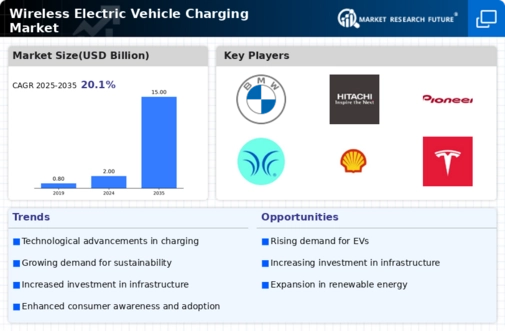Top Industry Leaders in the Wireless Electric Vehicle Charging Market
The wireless electric vehicle (EV) charging market is witnessing rapid evolution, characterized by innovation and intense competition. As the global shift towards EVs gains momentum, this market emerges as a hotspot for both established industry leaders and agile startups. In this dynamic landscape, we will delve into key strategies, emerging trends, and factors shaping the competitive scenario.
Key Player Strategies:
Prominent players shaping the wireless EV charging market include Plugless Power (USA), WiTricity (USA), Nission (Japan), Qualcomm Inc. (USA), ZTE Corporation (China), ELIX Wireless (Canada), HEVO Power (USA), Continental AG (Germany), Toshiba Corporation (Japan), and BMW (Germany), among others.
Established corporations such as Siemens and WiTricity are strategically leveraging their expertise in power infrastructure and magnetic resonance technology. Their approach involves developing comprehensive charging solutions that encompass both hardware and software platforms. These industry giants actively form partnerships with automakers and infrastructure providers, positioning themselves to secure dominant market positions.
Agile startups like Electreon and Plugless Power are carving out niches by specializing in specific applications. For instance, Electreon focuses on dynamic on-road charging for public transport fleets, while Plugless Power targets low-power applications like electric scooters and delivery vehicles. This targeted strategy allows startups to gain traction in specific segments before expanding their offerings.
Recognizing the importance of interoperability, key players like Qualcomm and the Wireless Power Consortium (WPC) are leading efforts towards standardization. By establishing common protocols and technical specifications, these industry leaders aim to create a unified ecosystem that fosters healthy competition and accelerates market adoption.
Factors for Market Share Analysis:
Several factors play a crucial role in determining market share within the wireless EV charging landscape:
-
Technological Prowess: Companies with advanced magnetic resonance technology, offering higher efficiency and longer charging distances, gain a competitive edge. Continuous research and development (R&D) and partnerships with research institutions are essential for maintaining this advantage.
-
Cost-Effectiveness and Scalability: Manufacturers competing on price and offering modular, scalable solutions for diverse applications attract wider adoption. Partnerships with infrastructure developers and the provision of financing options can further drive market penetration.
-
Strategic Partnerships and Ecosystem Integration: Building robust partnerships with automakers, infrastructure providers, and energy companies is paramount. Creating seamless charging experiences that integrate with existing infrastructure and energy grids becomes a key differentiator.
New and Emerging Trends:
Several trends are shaping the future of the wireless EV charging market:
-
Dynamic Charging for Public Transport: Companies like WiTricity and Ground Effect are pioneers in developing dynamic charging systems for electric buses and taxis, eliminating the need for static charging stations and reducing downtime. This has significant potential for enhancing public transport efficiency.
-
V2X and Smart Grid Integration: Integrating wireless charging with vehicle-to-everything (V2X) technology and smart grids opens up new possibilities. Vehicles can act as energy storage units, exchanging power with the grid and optimizing energy use.
-
Low-Power Applications: Beyond high-power vehicles, companies are developing low-power wireless charging solutions for e-bikes, scooters, and even robots. This expands the addressable market significantly and fosters wider EV adoption.
Overall Competitive Scenario:
The wireless EV charging market is marked by intense competition with diverse players. While established companies leverage their resources and brand recognition, nimble startups innovate rapidly and carve out specific niches. Collaboration and standardization efforts are crucial for ecosystem growth, while technological advancements in efficiency, scalability, and cost-effectiveness determine market leadership. Companies adapting to emerging trends like dynamic charging, V2X integration, and low-power applications stand to reap the rewards of this burgeoning market.
Key Takeaways:
-
The wireless EV charging market offers significant growth opportunities, attracting diverse players.
-
Success depends on a balanced approach of technological advancements, strategic partnerships, and cost-effectiveness.
-
Adapting to emerging trends like dynamic charging and V2X integration is critical for market leadership.
-
Collaboration and standardization efforts are essential for building a robust and scalable ecosystem.
Industry Developments and Latest Updates:
Plugless Power (USA):
On December 12, 2023, Plugless Power announced a partnership with Fisker Inc. to provide wireless charging systems for Fisker's Ocean SUV. The pilot program is set to launch in 2024 with 100 charging stations in Los Angeles and Miami (Source: Plugless Power press release).
WiTricity (USA):
On October 26, 2023, WiTricity announced a partnership with BMW to develop long-range wireless charging systems for electric vehicles (Source: WiTricity press release).
Nission (Japan):
On July 5, 2023, Nission launched a commercial wireless charging service for taxis in Yokohama, Japan (Source: Nission website).
Qualcomm Inc. (USA):
On December 19, 2023, Qualcomm Inc. announced the development of a new chip that will enable more efficient and longer-range wireless charging for electric vehicles (Source: Qualcomm press release).
ELIX Wireless (Canada):
On December 7, 2023, ELIX Wireless announced a partnership with Magna International to develop wireless charging systems for electric trucks (Source: ELIX Wireless press release).









